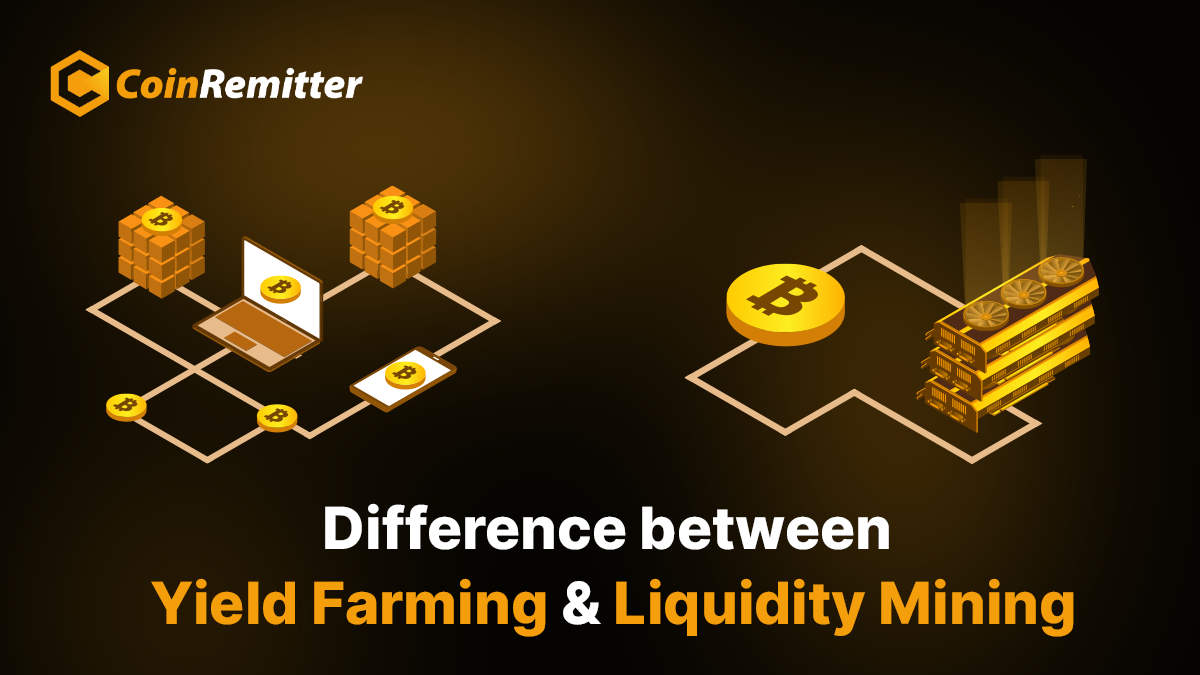Difference between Yield Farming and Liquidity Mining

Decentralized Finance has emerged as a transformative technology, reshaping how we manage finances. By removing third-party intermediaries and centralized institutions from financial transactions, the platform allows users to take control of their assets. However, within the Defi ecosystem, two concepts have received significant attention: Yield Farming and Liquidity Mining. Understanding the distinction between these two concepts is important to make smart DeFi investment strategies. This blog will look at the key distinctions between yield farming and liquidity mining.
Yield Farming
Yield farming is a way to earn rewards by depositing tokens into a liquidity pool on the Defi platform. These rewards are given in the form of the platform’s governance tokens. The most common methods of yield farming involve adding crypto assets to either a decentralized lending pool or a trading pool to provide liquidity.
In return for this liquidity, providers earn an annual percentage yield (APY), which is often paid out in real-time. DeFi projects use yield farming to encourage people to use their platforms and to reward the community for providing the liquidity that keeps these platforms running.
How does it work?
To understand how yield farming works, let us take the example of PancakeSwap. To start “farming,” a user must choose two assets, let’s say ETH and CAKE, and allocate them in a pool, let’s say “the ETH/CAKE pool.” In return, the user will receive LP (Liquidity Provider) tokens, representing its share of the pool.
The user will now take these LP tokens to the yield farm section to stake them. By doing this, the user is lending his LP tokens to the platform. As a reward for providing liquidity and participating in the yield farm, the user will earn additional tokens. These rewards come from two sources: transaction fees generated by trades in the pool, and extra tokens provided by the platform as an incentive.
Advantages of Yield Farming:
Higher Returns: Some DeFi projects offer high returns that are better than traditional financial options. Depending on market conditions, users can potentially earn significant profits on their investments.
Passive Income: Instead of just holding their crypto, users can use it to earn extra tokens and fee income without active trading.
Disadvantages of Yield Farming:
Impermanent Loss: Impermanent loss happens when users provide liquidity to a pool with two different tokens, and the prices of those tokens change relative to each other, causing a loss in value.
Market Saturation: The rise of yield farming has created many projects and platforms, leading to a crowded market. As more users join, competition for rewards and fees increases. This can reduce returns.
Liquidity Mining
Liquidity mining is a way for investors to earn cryptocurrency rewards by providing liquidity to exchanges or other decentralized applications. In exchange, they receive rewards in cryptocurrency, funded by small fees charged to users.
How does it work?
Let us understand this with an example. A trading protocol like Uniswap uses an autonomous liquidity pool with two tokens, X and Y, for trading. To ensure users can buy and sell these tokens without major price changes, liquidity is needed in both tokens. Liquidity providers deposit equal amounts of X and Y into the pool to provide this liquidity. As users trade X for Y and vice versa, they pay a trading fee.
These fees, along with rewards in the protocol’s governance tokens (like UNI for Uniswap), are distributed to liquidity providers based on how much they have deposited. If there’s an imbalance between the two tokens, the Automated Market Maker (AMM) adjusts prices to attract more liquidity. To withdraw their earnings and rewards, liquidity providers must remove their assets from the pool back into their crypto wallets.
Advantages of Liquidity Mining:
Portfolio Diversification: Liquidity mining allows users to spread their crypto investments. By providing liquidity to multiple protocols, they can own various tokens and projects, lowering risk and increasing profit potential.
Easy Withdrawals: Liquidity mining lets users take out their funds whenever they want. This gives them control over their assets, so they can manage their liquidity however they like.
Disadvantages of Liquidity Mining:
Smart contract Issues: DeFi platforms and protocols use smart contracts, which might have bugs or be vulnerable to hacks. This could lead to losses for users if a protocol gets exploited.
Defi Frauds: Scams like rug pulls and exit scams are common in DeFi, and liquidity providers are frequent targets.
Difference Between Yield Farming and Liquidity Mining
Risk Profile:
Yield farming is risky because it involves moving assets between liquidity pools or providing liquidity to them. Liquidity mining is even riskier because it involves adding liquidity to a specific cryptocurrency to boost its liquidity.
Reward Mechanism:
In Yield farming, participants get rewards as APY on the assets they lock-in. In liquidity mining, rewards come in the form of LP tokens and Governance (GOV) tokens for the liquidity providers.
Focus:
Yield farming involves various ways to make money with cryptocurrencies, like lending, borrowing, and other activities in DeFi. On the other hand, liquidity mining is all about encouraging people to provide liquidity, or funds, to decentralized exchanges and pools where cryptocurrencies are traded.
Conclusion
Both yield farming and liquidity mining offer different ways to invest in DeFi. However, investors need to understand how these methods work to achieve expected returns. Knowing the differences between these concepts can help make informed decisions. Before getting involved in DeFi, it's crucial to research and grasp the risks involved. Choose your approach based on your goals, how much risk you're comfortable with, and how long you plan to invest.
Over 38,000 merchants are using CoinRemitter
Join them now



